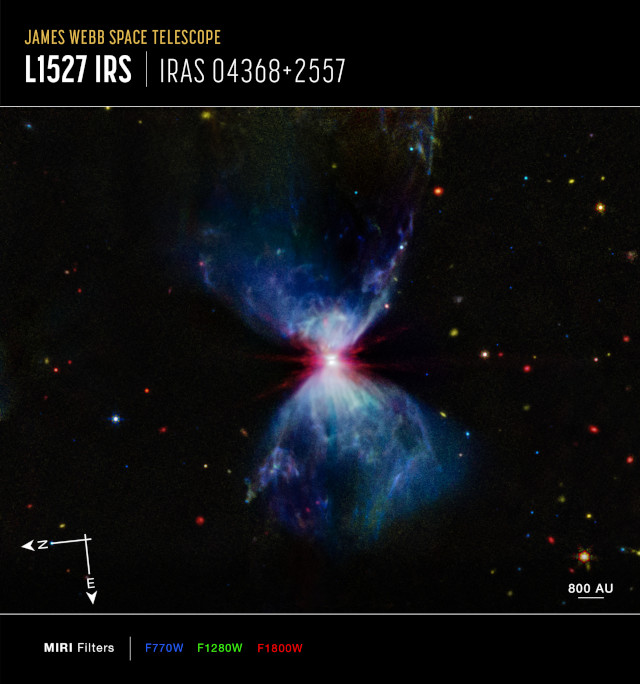
A new image captured by the James Webb Space Telescope reveals new details of a protostar forming within the molecular cloud cataloged as L1527. The MIRI instrument offered new information on the ongoing processes that are leading to the birth of a new star. An accretion disk is barely visible edge-on and is important because the protostar is still absorbing materials from it and planets could form within it in the future. During its formation, the protostar emits jets of gas that collide with the remains of the surrounding cloud, generating the structures MIRI sees in a color that is blue in the top image (NASA, ESA, CSA, STScI) thanks to the presence of polycyclic aromatic hydrocarbons (PAHs), compounds that are common in space.
Star formation processes remain among the main topics of study for astronomers. The James Webb Space Telescope immediately became another very useful investigative instrument for this type of study to be used to capture new details of star formation.
The L1527 molecular cloud was already studied with various telescopes and in 2022 it was observed for the first time with Webb, in that case, in particular with the Near-Infrared Camera (NIRCam) instrument. In the near-infrared, the effect visible in the bottom image (NASA, ESA, CSA, STScI. Image Processing: Joseph DePasquale (STScI), Alyssa Pagan (STScI), Anton M. Koekemoer (STScI)) is that of a region in space on fire.
Filaments of molecular hydrogen detected by NIRCam suffer the shock wave of the jets emitted by the protostar. They inhibit the formation of other stars nearby. Other stars are forming in molecular clouds a little further away.
The Mid-Infrared Instrument (MIRI) offers a somewhat different view of the L1527 molecular cloud. NIRCam mainly shows light that is reflected by dust while MIRI sees it in the mid-infrared and offers a view that includes the consequences of material emissions on thicker areas of gas and dust.
About 460 light-years away from Earth, the protostar in the L1527 molecular cloud has an estimated age of around 100,000 years. That’s a very short time in astronomical terms and over the course of many more millennia, the protostar will complete its formation. The consequence will first of all be the triggering of nuclear fusion within its core. At that point, the remnants of the molecular cloud will be swept away.
The combination of near- and mid-infrared observations offers a more complete view of the L1527 molecular cloud. The behavior of this forming system can be studied over time, first of all, to see the details of the star formation processes. The presence of PAH-type compounds is also interesting because they are important in the formation of amino acids, the building blocks that form large biological molecules, therefore they could deserve follow-up studies thinking about the possible formation of planets around the protostar.


